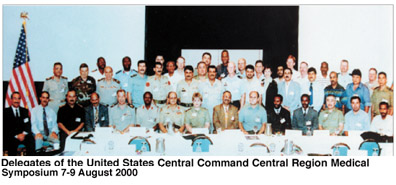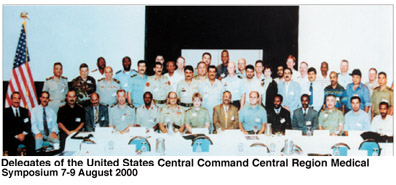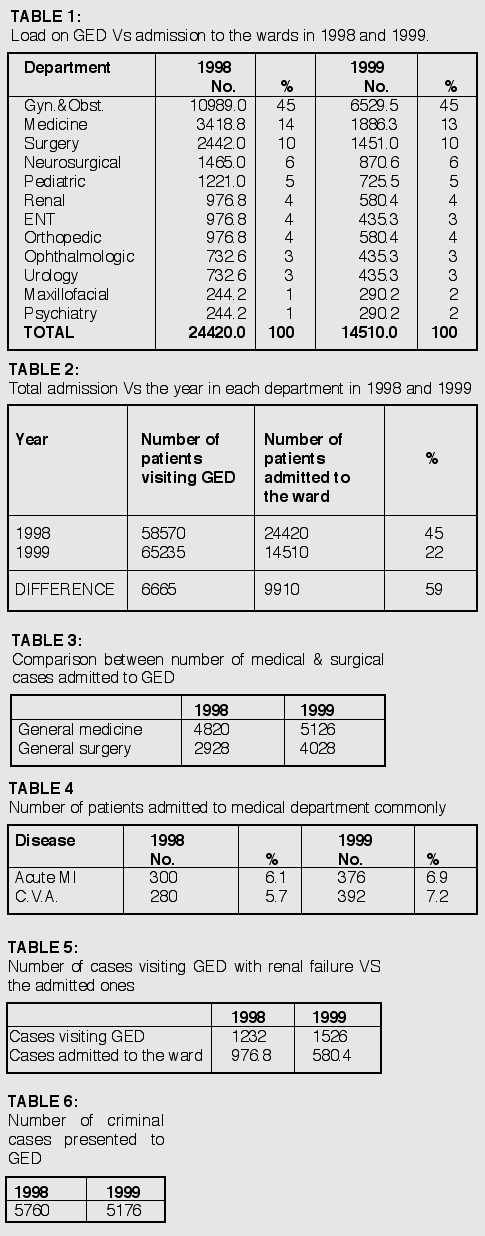
Emergency Systems in Yemeni Hospitals [Archives:2001/17/Health]
April 23 2001
Dr. A. Samad A.R. Al Hakimi
Consultant and head of G.E.D.
Al-Thawra Modern Teaching Hospital
[email protected]
Information on the main causes of ill health and death in a nation is very important for planning, monitoring and evaluation of health services. Routine data collection through vital registration systems, hospital and other health care delivery system, disease notification systems and epidemiological surveys are the conventional sources of data for health care. There has been a tremendous improvement in the provision of health services in the last decade. Records of admission into health care facilities remain one valuable source of data on ill health available to developing countries. Al-Thawra GMH, Sana’a is the tertiary hospital of Sana’a as well of Yemen. It is the first teaching hospital. It was constructed in1964. It has 532 beds and is a well equipped center. Most of the staff of consultants are members of the Faculty of Medicine of Sana’a University. It includes all departments and well-equipped medical and surgical intensive care units. All surgical operations are carried out in it. In the last two years two cases of kidney transplantation were carried out here successfully. This year, the cardiac surgical center will start working. There is a busy outpatient department with specialized referral clinics and 24 hours emergency services. There are 128 medical beds (80 male).
In order to provide information and awareness, a study was prepared to determine the load difference between 1998 and 1999 of cases visiting GED and the pattern of admission to the hospital, to identify and present the size of the problem and inform about the load difference yearly to the authorities.
Emergency Department Admission Study:
This study is aimed at determining the load on General Emergency Department (GED), pattern of admission into Al-Thawra General Modern Hospital (GMH) in 1998 and 1998. Through a retrospective study of medical records of Al-Thawra GMH for the two years 1998 and 1999, it was found out that 58,570 patients sought medical advice at the GED of Al-Thawra GMH in 1998. Of them 24,420 patients (45%) were admitted to different departments. While 65,235 patients sought medical advice from GED in 1999, of 14,510 cases (22%) were admitted into the hospital. The average number of admission in 1998 was 67.8 patients per day. While the average admission in1999 were 40.3 patients per day. Admission into obstetric ward topped the list (45%) because of a high rate of normal delivery as the leading cause of admission into this ward. Admission to medical ward was the second (14%) with acute MI and CVA as the most common cause of admission to the same ward. Admission to surgical ward was the third (10%) with acute abdominal complaints as the leading cause of admission. The rate of admission to the above department respectively was 4.5: 1.4: 1.
Table (1) demonstrates that total number of cases who visited the GED of Al-Thawra GMH Sana’a increased in 1999 with an increase of 6,665 patients (0.089%). Table (1) also demonstrates that the total admission in 1998 was 24,420 (45%) compared with that of 1999 where the total admission was 14,510 patients (22%). Table (2) demonstrates the pattern and frequency of admission to different departments in both years, 1998 and 1999, with obstetric cases as the most frequent ones (45%). These reflect the same pattern of admission as in 1999. Table (3) shows the load difference of cases visiting GED with medical causes versus those with surgical causes in the two consecutive years 1998 and 1999, with a load difference of 306 (0.05%) of medical causes, and 1,100 of surgical causes (11%). (90%) of them were admitted to the medical ward in 1998, while only (37%) of cases were admitted in 1999 to the same department. (83%) of cases were admitted to the surgical ward in 1998, while only (49%) of cases were admitted to the same ward in 1999. This difference in admission in both years may be because admission in 1998 was free. Table (5) demonstrates that the load difference in GED of patients presented with renal failure increased by 294 patients (4.2%) in 1999 while the load difference of those admitted to the renal dialyses unit in both dropped by 396.4 patients in 1999. This discrepancy between increasing the load in GED and decreasing the load of admission may be due to the introduction of a fee system which was started in 1999. Table (6) shows that the load of criminal cases dropped by 589 patients (1.1%) in 1999.

Conclusion:
There was a heavy load on GED of Al-Thawra GMH in 1998 and 1999 with a variety of diseases, but with decrease in admission services. So, re-evaluation and planning of health services of Sana’a and Yemen is inevitable.
Situation in Yemen as reported by Canadian Delegation and WB:
The Canadian Medical Delegation visited Yemen, during Oct. 18 – Nov. 6, 2000. That was the 10th of a series of visits by Canadian physicians to Yemen. The protocol of these visits is that they occur on invitation from Yemen, and the purpose is to encourage friendly contacts between Canadian and Yemeni physicians and to support the development of health care in Yemen as occasions arise for the Delegation and its members.
In their commentary on Hospitals Visited by the Delegation, they said:
“We visited many hospitals in areas of Sana’a, Taiz, Al Mukalla and Seyun. Many of these hospitals we had previously visited in 1999, and we observed progress in a number of areas in some of them.
The Emergency Department in Al Thawra Hospital in Sana’a is being enlarged. The Director, Dr. Hakimi, has taken time for personal continuing medical education. He has introduced a system of charting in the emergency department from which he is able to generate statistics concerning the activities of the department.
He continues to work in educating the staff in the management of emergency situations. He is beginning to be able to demonstrate trends concerning the situations involving the department. Although he is kept very busy in the Department, in our view, he might become a national resource person for Emergency Physician training and programs for advice as regards some managerial issues in other parts of Yemen.”The World Bank report by Wilma Mac Pherson in January 2000 stated the following improvements:
– New GED with integral ICU
– Resuscitation area identified and training program for Advanced CPR and CPR now in place
– New casualty records, doctor coding and diagnostic coding begun
– Comparative statistics maintained on Power Point
– Greater degree of privacy for patient.
– Imaging facilities continue to improve
– There are more Yemeni doctors of high caliber and fewer Russian and other East European doctors in charge of care. This is great improvement.
– There appears to be a greater involvement of nurses in direct patient care.
AL-THAWRA TEACHING HOSPITAL Sana’a, Republic of Yemen
RECOMMENDATIONS
– All hospitals and doctors referring cases to the GED should notify the GED in ADVANCE of the impending referral to ensure proper care.
– The Al Thawra GED should be utilized as a center for advanced emergency care, not as a primary care clinic.
– A hospital council should be established to organize and monitor the work of emergency ward.
– Serious thought should be given to constructing a network of local centers and regional hospitals specializing in Car Accident & Trauma.
– Strong efforts be made to improve the financial status & morale of the medical staff.
– The GED staff should consist of an independent team of specialized physicians trained in emergency medicine, including BLS and ACLS.
Comparison with the United States:
It would be of help to study the classification of physical status adopted by American Society of Anesthesiologists, so as to create a comparison between the situation here and that in the United States as an example of high quality health care.
Class1-A normal healthy individual
Class2- A patient with a mild systemic disease
Class3- A patient with a severe systemic disease that limits activity but is not incapacitating
Class4-A patient with an incapacitating systemic disease that is a constant threat to life
Class5- A moribund patient who is not expected to survive 24 hrs with or without surgery
In February issue 98,. Dr. Al Munibary, Present Minister of health, hoped that the Emergency Unit in Al Thawra Hospital has improved to what it has today. Now, next step is to seek further improvement in order to keep pace with the progress happening in this respect in the rest of the world.
Emergency Medical Services
(American public law(93-154)1973
THIS LAW IDENTIFIED 15 ELEMENTS OF AN EMS SYSTEM:
1-PERSONNEL.
2-TRAINING
3-COMMUNICATION.
4-TRANSPORTATION.
5-FACILITIES.
6-CRITICAL CARE UNITS.
7-PUBLIC SAFETY AGENCIES.
8-CONSUMER PARTICIPATION.
9-ACCESS TO CARE.
10-TRANSFER OF CARE.
11-STANDARDIZATION OF PATIENTS’ RECORDS.
12-PUBLIC INFORMATION & EDUCATION.
13-INDEPENDENT REVIEW & EVALUATION
14-DISASTER LINKAGE
15-MUTUAL AID AGREEMENTS.
(EMERGENCY MEDICINE (A Comprehensive study guide)fifth edition-1999 TUDITH E TINTINALLI ,GABER KELEN (SECTION ONE PREHOSPITAL CARE )

——
[archive-e:17-v:2001-y:2001-d:2001-04-23-p:./2001/iss17/health.htm]


